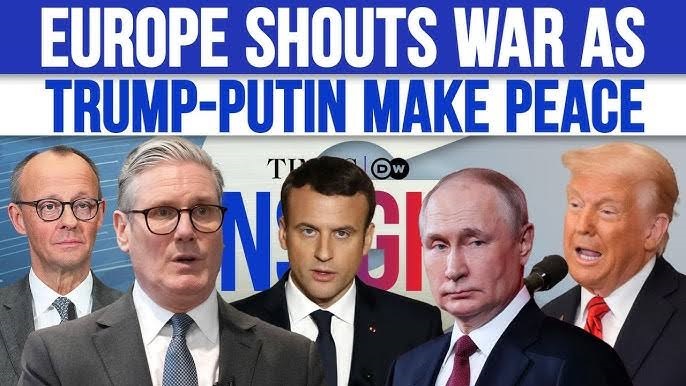
Despite the hysteria fanned by DC and European think tanks alike neither Putin nor other serious Russia officials have expressed their desire to conquer Europe, writes Doug Bandow, a Senior Fellow at the Cato Institute and a former Special Assistant to President Ronald Reagan.
Despite the enormous frustration over Europe’s policy lassitude expressed by a cavalcade of American policymakers, even today, in the Age of Trump, Europeans remain overwhelmingly dependent on Washington for their security. President Donald Trump’s eruptions have caused America’s allies to create elaborate charades to convince him that his dictates are being followed, but the recently announced 5 percent GDP standard for military outlays allows 1.5 percent for civilian purposes and won’t take effect until he has long been out of office. One suspects that European governments will then press for reconsideration of the NATO requirement.
Neither significant nor consistent defense spending increases are likely in coming years given burgeoning social strife and political instability across Europe. Established ruling parties are suffering and incumbent governments are tottering across the continent. Last month NBC reported, “For the first time in modern history, far-right and populist parties are simultaneously topping the polls in Europe’s three main economies of Germany, France and Britain.” Italy and Slovakia have moved right-nationalist. Traditional dominant parties are also under siege in Belgium, Czechia, Netherlands, Spain, and Sweden.
Nevertheless, many of the same governments appear ready for war with Russia — which means sending American forces off to battle Russia, as any conflict involving NATO would inevitably play out. The aggrieved cite intrusions in allied airspace and alleged drone and balloon flights interfering with commercial aviation. Complaints about presumed sabotage operations expand the list. Seemingly shocked European officials and apocalyptic analysts, led by the ever-hawkish Polish and Baltic governments, mutter darkly about having to fight Moscow.
Charged Ivo Daalder, a former U.S. ambassador to NATO: “Russia is at war with Europe. It has been waging an overt war in Ukraine for over a decade now, and with increasing ferocity since its full-scale invasion in 2022. But the fighting in Ukraine is only part of Russia’s wider war against Europe as a whole.”
No doubt, Russia is active in Europe, though presuming that all malign activities originate in Moscow ignores the continent’s indigenous proclivity for conflict. Since the Second World War, even democratic European states have suffered through military coups, civil wars, secessionist movements, terrorist attacks, political assassinations, mass protests, social conflict, and extremist politics. Blaming everything on Vladimir Putin conveniently allows guilty Eurocrats to sidestep painful domestic challenges, bolster hawkish international campaigns, and disguise responsibility for the destructive Ukraine war.
More important, Putin’s war on Ukraine was not then and still is not directed at Europe, let alone America. Russian officials made clear why they had a uniquely neuralgic reaction to Kiev joining NATO, and allied officials recognized that moving to induct Ukraine, even if informally — bringing the alliance into Ukraine rather than Ukraine into the alliance — would risk war.
Of course, it is still natural for Europeans, especially those living near Ukraine, to feel threatened by the conflict. Yet, despite the hysteria fanned by DC and European think tanks alike neither Putin nor other serious Russia officials have expressed their desire to conquer Europe. What would they hope to gain by doing so?
Still, America and Europe are effectively at war with Russia. But not because the latter chose combat with them. The NATO allies are responsible for the ongoing conflict.
The US and Europe launched a comprehensive proxy war against Russia. The allies financed and equipped Kiev’s military. Washington and other governments provided intelligence support. The CIA built and equipped facilities in Ukraine and even staffed some of them. European militaries also introduced support troops, to train Ukrainian personnel, operate new weapons systems, and undertake non-combat defense duties. There have been unconfirmed reports of foreign “mercenaries” serving Kiev, thought to be allied military personnel involved in unofficial combat roles.
Even more significant is the ongoing debate over which arms, and with what range, to provide to Ukraine. In a major escalation, the Trump administration appears ready to provide Kiev with nuclear-capable Tomahawk missiles.
In short, American and European governments are at war with Russia. Because of allied support Ukraine has been able to hit more distant targets and wreak ever greater damage.
To these provocations Moscow has responded only minimally.
Yet, pressed by the Baltic countries — including through the European Union’s de facto foreign minister, Kaja Kallas — whose shared Russophobia far outranges their combined military capabilities, allied commentators and officials have been engaging in crazy talk and proposing reckless actions, such as shooting down Russian aircraft, which could trigger armed and even nuclear conflict. Moscow has long relied on tactical nuclear weapons to fill its conventional gap with the US and has far more at stake than NATO members in the current war. Full-scale conflict would mean ruling nuclear dice.
This strategy, if it deserves that term, is madness. Bad enough, a continent that failed to prepare for war and remains dependent on America bailing it out is threatening to initiate open hostilities with Russia. Even worse, a U.S. president who once criticized Europe for failing to prepare for war appears to be encouraging the continent to start one that it is unlikely to win without American participation, in which case nukes could end up flying across the Atlantic. Europe choosing continued irresponsibility is to be expected. Washington choosing suicide is not.
Imagine how Dwight D. Eisenhower, the supreme allied commander during the Second World War, first NATO Supreme Allied Commander Europe, and two-term president, would judge such behavior. He supported the transatlantic alliance, but as a temporary measure. He explained in 1951: “If in ten years, all American troops stationed in Europe for national defense purposes have not been returned to the United States, then this whole project will have failed.”
A recent study from the International Institute for Strategic Studies concluded that “the challenges for European NATO allies to develop military capabilities quickly are significant. The gaps in military hardware and software are considerable… Moreover, Europe’s defense industries continue to face challenges in increasing production fast enough, while many European armies cannot meet their recruitment and retention targets.”
In this world feckless NATO members, urged on by Donald Trump, are now advocating that the alliance, mostly meaning the US, prepare for war with Russia. When does the administration plan on asking the American people about whether they want to risk national destruction for the feckless Europeans? This is the moment for Trump to unequivocally put America first.
read more in our Telegram-channel https://t.me/The_International_Affairs

 11:47 13.10.2025 •
11:47 13.10.2025 •






















